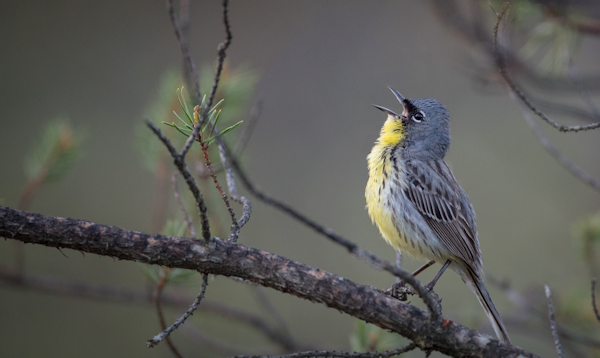SEJournal Online is the digital news magazine of the Society of Environmental Journalists. Learn more about SEJournal Online, including submission, subscription and advertising information.
 |
| The decline of birds is a complex story with multiple causes. Above, the Kirtland’s warbler, one of the rarest songbirds in North America. Photo: Ian Davies, Cornell Lab | Macaulay Library. |
TipSheet: As Bird Populations Crash, Local Reporting Can Help Untangle Why
By Joseph A. Davis
Bird populations are declining globally. And in North America, a key 2022 report found that more than half of U.S. and Canadian bird species have suffered dramatic drops in population.
Local and regional developments make this a story for environmental journalists to explore. But brace yourself. There may be very bad news — near you.
Why it matters
Birds are central to the health of the ecosystems they live in. They pollinate plants (many of which people enjoy and/or depend on). They eat things we often wish not to have around, such as insects or carrion. Also, they may feed us.
They may spread disease (and often suffer from disease). And they are (no apologies for the pun) the “canary in the coal mine” when it comes to habitat loss or toxic substances in the environment.
Birds provide us humans with joy and
wonder almost everywhere we
encounter them in our world.
Also, birds are awesome. They provide us humans with joy and wonder almost everywhere we encounter them in our world. They are beautiful. They are capable of incredible feats. And their songs and calls brighten and beautify our lives.
The backstory
The decline of birds is a complex story with multiple causes. The key in many cases, though, is human action.
As European settlers to North America cut forests, drained wetlands, plowed grasslands, built reservoirs, dug up minerals and paved much of what remained, birds have had a tougher time finding homes and food — and raising their young.
It’s not just that. A lot of birds eat insects, and insect populations are also declining dramatically. So that may be part of the explanation. Behind that decline may be the massive agricultural use of pesticides.
Story ideas
- Find local birding clubs (see link below), attend meetings, talk to leaders, go on walks and ask about local species, local declines and local threats to birds.
- Are there unique habitats in your area? Species specially adapted to those habitats? Dramatic changes to those habitats?
- What birds migrate through your area? Are their food sources and resting places under threat?
- What diseases afflict what birds in your area? Those could vary from bird flu to West Nile virus. Do human activities promote the spread of disease?
- What is the role of backyard bird feeders in your ecosystem? Some call them “cat feeders.” Do they help or hurt? Spread disease?
- What is the role of “outdoor” or feral cats in the decline?
- What is the role of big buildings and glass windows in the decline?
- What is going on with tree cover and wetlands in your area? Is climate change a factor?
Reporting resources
- Cornell Lab of Ornithology: This institution, part of Cornell University’s College of Agriculture and Life Sciences, has all kinds of bird-related resources.
- National Audubon Society: A premier national nonprofit for conservation and policy, as well as just birding. It has a network of local and regional affiliates.
- Christmas Bird Count: A long-standing tradition in many places that can give some unscientific sense of population trends. Organized by National Audubon. Ask your local chapter about its results.
- Local/regional birding and conservation groups: Start here. There are probably others not on the list.
- U.S. Fish and Wildlife Service: The federal agency most active in bird conservation. Find a refuge near you and talk to the staff. You can also reach out to managers of your state, local and private wildlife refuges.
- National Wildlife Health Center: This unit of the U.S. Geological Survey is an authoritative source on bird disease.
- North American Bird Conservation Initiative: The consortium of researchers, government agencies and conservation groups that produced the 2022 report mentioned above.
- Ducks Unlimited: Yes, its members do hunt ducks — but they work very hard for conservation. Check in with your local chapter and talk to them about migratory birds.
- State conservation agencies: Terminology varies, but a good directory can be found here.
- People who maintain local backyard bird feeders: One way to find them is to go to a hardware store where feeders and seed are sold. Talk to customers.
[Editor’s Note: For more on covering bird populations, see a Toolbox on a bird migration explorer, TipSheets on talking to birders and the problems of lead ammunition, and a Feature on an iconic grassland bird, plus BookShelf reviews on “The Bird Way” and on long-distance migrators and a Q&A of a book about puffins.]
Joseph A. Davis is a freelance writer/editor in Washington, D.C. who has been writing about the environment since 1976. He writes SEJournal Online's TipSheet, Reporter's Toolbox and Issue Backgrounder, and curates SEJ's weekday news headlines service EJToday and @EJTodayNews. Davis also directs SEJ's Freedom of Information Project and writes the WatchDog opinion column.
* From the weekly news magazine SEJournal Online, Vol. 8, No. 24. Content from each new issue of SEJournal Online is available to the public via the SEJournal Online main page. Subscribe to the e-newsletter here. And see past issues of the SEJournal archived here.













 Advertisement
Advertisement 



